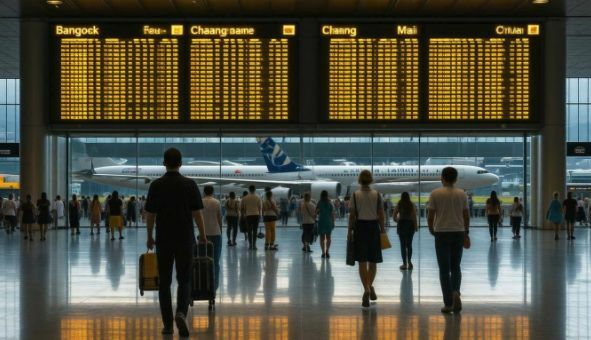Cost to move from the US to Thailand: A complete expat budget guide

Moving to a new country can be both exciting and overwhelming, especially when you’re transitioning from the USA to Thailand. You might be dreaming of sandy beaches and bustling markets, but before you pack your bags, it’s crucial to understand the costs involved in this big change. From shipping your belongings to planning your travel and finding accommodations, every detail counts. In this guide, we’ll break down what you can expect to spend during your move, helping you to create a budget that won’t leave you with surprises along the way. So, let’s dig into the numbers and plan your adventure!
The average cost to move from the USA to Thailand typically ranges from $3,000 to $10,000, depending on various factors such as the volume of belongings being shipped and the distance involved. It is advisable to obtain quotes from multiple moving companies for a more accurate estimate tailored to your specific situation. The cost to hire full service international movers is usually much higher than a service that just does the shipping.

Estimating Your Moving Budget
To create a realistic moving budget, it’s essential to take a comprehensive look at all potential costs associated with relocating from the USA to Thailand. This means going beyond just ticket prices and focusing on each step of the moving process. The first major category you should consider is international shipping and freight. This cost can significantly vary based on the volume of your belongings and the distance they need to travel. Expect costs to range from $3,000 to $10,000.
Think about what items are essential and what can potentially be left behind or sold; every dollar counts.
Next up is packing and moving services. Many expats opt for professional services that typically range between $2,000 to $5,000. These services include packing your items, transporting them, and unpacking once they arrive at their destination. It may seem like an upfront expense, but consider the peace of mind that comes with having experts handle your valuable possessions. Furthermore, don’t hesitate to get several quotes to ensure good value for your money.
Equally important are your travel arrangements, which brings us to flights. A one-way ticket from the USA to Thailand can range from $600 to $1,500, influenced by factors such as the time of year and airline deals available at the time of booking. When planning this part of your budget, it might be beneficial to keep an eye on flight trends or sign up for fare alerts.
Another critical aspect of your budget will be visa fees. As many find the Thai Elite Visa appealing due to its simple application process, keep in mind that these fees can vary widely—from $600 to $2,000 depending on the specific tier you choose. You want a visa that not only meets your needs but also fits well within your budget.
Remember, it’s worth doing some research into various visa options early; after all, delays could impact your move-in timeline and living arrangements.
Finally, if you’re not immediately settling into a permanent residence upon arrival, include temporary accommodation in your calculations. Expect costs around $50 to $100 per night while getting acclimated and searching for a more permanent living situation.
| Budget Item | Estimated Cost Range |
| International Shipping | $3,000 – $10,000 |
| Packing and Moving Services | $2,000 – $5,000 |
| Flights | $600 – $1,500 |
| Visa Fees | $600 – $2,000 |
| Temporary Accommodation | $50 – $100 per night |
Considering these varied cost components will help you prepare financially for this exciting transition while minimising unexpected surprises along the way. With a clear understanding of your moving expenses, you’re now ready to explore how best to handle logistics once you arrive.
Shipping and Freight Costs
The most significant expense when relocating internationally is often the shipping and freight costs. For example, shipping a 20-foot container can set you back around $6,000, while a 40-foot container may bump the cost up to nearly $10,000. If you’re looking to save money, shared containers allow you to consolidate your shipment with others. This approach not only cuts down on costs but also maximises space efficiently. The only downside? It might add some extra time to your travel plans.
Factors Affecting Costs
Several factors play into how much you’ll spend:
- Volume and Weight: Naturally, heavier and bulkier shipments incur higher costs. Think about it—if you’ve got an extensive collection of books or furnishings, brace yourself for a hefty bill.
- Distance: The further your goods need to travel—say from Los Angeles to Bangkok—the more expensive your shipping will become. Geographical considerations truly dictate pricing.
- Method of Transport: Choosing between airfreight and sea freight can significantly impact your budget. Airfreight is considerably quicker; however, it often comes at a much steeper price. Conversely, while sea freight takes longer—sometimes weeks or even months—it can be up to six times cheaper than airfreight on average.
- Seasonal Variations: Be aware that shipping rates can fluctuate based on the time of year. During peak seasons—like holidays—rates typically soar due to increased demand.
Understanding these aspects can help you plan effectively. For instance, if you have the luxury of time, opting for sea freight over airfreight can lead to considerable savings. By researching and planning well in advance, you can make smarter choices that won’t break the bank.
At the same time, always factor in potential customs fees and local taxes specific to Thailand, which could further affect your overall budget. Being informed about every component of your moving costs—including shipping—will help ensure a smoother transition into your new life abroad!
With shipping costs outlined, it’s essential to dive into the practicalities of preparing for your move and exploring available solutions for a seamless relocation.
Packing and Moving Services
When you’re preparing for a big move internationally, the last thing you want is to stress about every little detail. That’s where professional packing and moving services come into play. These services can significantly ease the burden of relocating, but it’s important to recognise their scope as well as the associated costs to ensure you’re getting the best value for your money.
A comprehensive moving service typically includes not only packing but also loading, transporting, unloading, and even unpacking at your new home. This means that when you hire professionals, you can rest assured that your belongings will be handled with care from start to finish.
For instance, established companies like Three Movers provide secure packing methods and promise timely delivery, starting at around $2,000. This fee generally covers several aspects: the labour involved in packing up your home efficiently, specialised materials needed to protect fragile items, and transportation costs that can vary based on distance.
However, while these services offer convenience and reliability, it’s wise to explore various options available.
You might think that smaller, independent movers could save you a few bucks; they often do offer budget-friendly alternatives. However, this doesn’t always guarantee peace of mind. Although these outfitters may quote lower prices, it’s essential to consider whether they have the same level of experience and resources as larger companies. Reliability should always be factored into your decision—especially when it comes to transporting your cherished belongings across borders.
Some tips for choosing a reliable moving service include:
- Research: Look for customer reviews on platforms like Yelp or Google.
- Ask for Referrals: Recommendations from friends or expat communities can yield trustworthy options.
- Inquire About Insurance: A good moving company should offer insurance against potential loss or damage during transit.
Another aspect of utilising professional moving services is understanding that there may be additional costs involved that aren’t part of the initial quote. Think about fees for accessing high-rise buildings, special handling for oversized items, or even additional insurance coverage. Logistics can become complicated quickly!
Knowing these intricacies beforehand can make your relocation smoother overall.
Lastly, budgeting for packing materials separately is often recommended. While many moving companies provide them at an added cost, you might find it more economical to purchase your own boxes and materials ahead of time. Look into local retailers or online marketplaces—this can help offset some of those steep moving costs while still ensuring everything stays protected during the journey to Thailand.
Marlo Bydon emphasises this point well: “The punctuality and professionalism of the moving service made the process seamless.” Her experience reflects just how valuable a reliable moving service can be in easing the stress of relocating.
Understanding these variables about packing and moving services helps you set realistic expectations—and ultimately leads to a more enjoyable transition to your new life abroad.
With all these details in mind regarding moving logistics and budget considerations, let’s now turn our attention to travel arrangements that will get you to your new destination seamlessly.
Flights and Transportation

Another substantial expense you’ll encounter during your move to Thailand is the cost of flights and local transportation once you land. When it comes to booking flights, timing can make a significant difference. For instance, you can find round-trip tickets from New York to Bangkok priced as high as $1,500 with premium airlines if purchased closer to departure dates. However, by booking several months in advance and considering budget airlines, that cost could drop to about $600.
To maximise savings, consider flexible travel dates. Flights tend to be cheaper during off-peak seasons, so if you’re able to adjust your plans slightly, you could enjoy considerable discounts.
Once you’ve booked your flight, it’s essential to think about how you’ll handle your luggage upon arrival. Many travellers overlook this aspect, but combining flights with separate shipping for excess baggage can often be more economical. This option allows you to avoid hefty airline fees for checked bags while ensuring your belongings arrive at a more manageable pace.
Upon landing in Thailand, logistics play a crucial role in the transition. Think ahead about getting around; using local movers for transporting your belongings from the airport or seaport to your new home is advisable. Typically, these services can range from $50 to $200, depending on the distance and amount of items being moved.
Just like securing a reliable flight is important, planning for local transportation costs wisely ensures a smoother relocation experience.
It’s beneficial to research local moving companies before arriving, as many offer packages tailored for expats and may even provide English-speaking staff. This support can ease communication and streamline the moving process.
Additionally, getting familiar with local transportation options such as taxis or public transit will aid in adjusting to city life in Thailand. Downloading transportation apps popular in the country will simplify navigating the streets of cities like Bangkok or Chiang Mai.
As you navigate the intricacies of travel arrangements and settle into your new environment, it’s also critical to identify any unexpected costs that might arise during this journey.
Hidden Fees and Additional Expenses

The enthusiasm of relocating to Thailand might make you overlook some hidden costs that come along with the territory. Think about customs duties first. These are often based on the value of your belongings and can range from 5 to 10% of that value. Not only does this add to your overall moving expenses, but there can also be unexpected variations depending on the nature of the items you’re bringing in. For example, electronics may incur higher duties compared to clothing or furniture.
Beyond customs duties, you might encounter several administrative fees during your move. These can encompass a variety of costs—from customs clearance charges to documentation fees for paperwork required by both U.S. and Thai authorities. Moreover, if your shipped belongings arrive earlier than anticipated, storage fees could add a few extra dollars to your budget while you finalise other arrangements.
It’s important to understand that shipping insurance is another key factor in budgeting for your move. Protecting your belongings against potential damage or loss can be invaluable in an international move. Insuring your shipment against unforeseen mishaps will typically cost between 1-3% of the total declared value.
To shield yourself from these unexpected financial burdens, it’s wise to allocate an additional 10-15% of your overall moving budget for these unpredictable expenses. This tiny cushion of extra funds can save you from a world of surprise costs down the line.
By planning for these charges ahead of time, you can ensure a smoother transition as you settle into your new surroundings. Let’s explore how these costs compare to other relocation scenarios.
Comparing Relocation Costs
Different countries and their respective moving services present a spectrum of relocation costs. When planning your move from the USA to Thailand, you might be looking at a price range from $5,000 to $15,000, depending on the size of your shipment and specific service requirements. This range fluctuates based on several elements including the shipping company chosen, the volume or weight of your belongings, and even the time of year when you decide to make the big leap.
Take a look at this brief comparison table showcasing typical costs for other international relocations:
| Country | Estimated Cost (shipping and services combined) |
| USA to Thailand | $5,000 – $15,000 |
| USA to UK | $4,000 – $12,000 |
| USA to Australia | $6,000 – $16,000 |
| USA to Canada | $3,000 – $8,000 |
| USA to Germany | $5,000 – $14,000 |
What’s interesting here is that while Thailand lies within the middle of this cost range compared to locations like Canada or the UK, it’s essential to recognise why these differences exist. The variance in costs isn’t merely about distance but is also influenced by factors like market stability, availability of shipping routes, and seasonal demand during peak moving months.
For instance, moving from the USA to neighbouring countries like Canada typically incurs lower costs due to shorter distances and established logistical frameworks. In contrast, relocating long distances to a country like Thailand involves additional complexities—from customs regulations to potential surcharges by moving companies aiming to accommodate those extra miles.
Furthermore, if you’re considering taking personal items with you including furniture or large appliances, expect these expenses alone to push the total bill higher. It’s crucial to focus on these costs while understanding how they can change depending on your unique situation—whether you’re taking significant household items versus just luggage or using full-service movers as opposed to self-service options.
As you weigh different relocation scenarios and gather quotes from multiple service providers, consider strategies that will help optimise costs. Exploring practical methods can create a smoother transition while effectively managing your budget.
Cost-Efficient Moving Tips
If you’re looking to shave some dollars off your relocation budget, the good news is there are plenty of straightforward tactics to employ. First up is decluttering. This means taking a good, hard look at your belongings and parting ways with items you no longer use or need. Not only does this reduce the volume and weight of what you’re shipping, but it also makes settling into your new home that much easier. Plus, you’ll feel a sense of relief having a lighter load when you arrive.
Now, let’s talk timing. Scheduling your move during off-peak seasons can lead to substantial savings. Just as airline prices fluctuate based on demand, so do moving costs. Planning your relocation outside of the summer months or around holidays can save you money since moving companies typically charge less during these quieter times.
Another smart strategy is adopting a DIY packing approach. Rather than hiring professionals to pack every single item, take the time to handle this yourself. It can be as simple as gathering boxes and packing up clothes and non-fragile items, leaving the heavy lifting—like furniture loading—to the pros. This way, you’re saving on packing labour while ensuring efficiency when the movers arrive.
Bundling services is also a fantastic option! Many moving companies offer bundled discounts for additional services like storage or unpacking assistance. If you anticipate needing these extras, inquire about them upfront; this could result in notable savings on your final bill.
Perhaps one of the most effective strategies is to negotiate rates with moving companies. A simple conversation can go a long way. Don’t hesitate to ask for discounts or mention quotes from other movers to see if they can price match or offer added value.
“I saved nearly $2,000 by downsising my belongings and shipping only essentials,” shared Geerten Dielissen, who moved to Chiang Mai recently.
By incorporating these strategic measures into your moving plan, you can significantly stretch your moving budget further and alleviate the financial stress associated with relocating abroad.
Using these cost-effective tips can provide significant savings, making your relocation not just manageable but also financially smarter as you embrace your new life in Thailand.
What factors influence the overall cost of relocating from the USA to Thailand?
The overall cost of relocating from the USA to Thailand is influenced by several key factors, including airfare, shipping costs for belongings, housing options, and lifestyle choices. For instance, international flights can range from $500 to $1,500 depending on the season and airline, while shipping a 20-foot container may cost between $2,000 and $4,000. Additionally, monthly rent varies widely from $300 in local areas to over $1,000 in expatriate-dominated neighbourhoods. Healthcare and food also play significant roles; with average healthcare costs being lower than those in the USA and street food options available for as little as $1 per meal. Overall budgeting should consider these variables to get a clearer financial picture.
Are there additional costs involved in obtaining visas and permits for living in Thailand?
Yes, there are additional costs involved in obtaining visas and permits for living in Thailand. Expatriates often face fees ranging from $30 for a tourist visa to over $200 for long-stay visas like the Non-Immigrant Visa, which can also require health insurance and proof of sufficient funds. Additionally, work permits can cost upwards of $60 and may involve visa runs or renewals, contributing to ongoing expenses that should be factored into your budget when moving to Thailand.
How can I budget effectively for an international move to Thailand?
To budget effectively for an international move to Thailand, start by creating a detailed list of all potential expenses, including shipping costs (which can range from $1,500 to $5,000 depending on the volume), visa and legal fees (around $300-$600), initial accommodation (approximately $300-$800 per month in major cities), and daily living expenses. Research expat forums and cost-of-living websites to gain insights into average prices and unexpected costs. Additionally, it’s wise to set aside a contingency fund of at least 10-20% of your total estimated budget for unforeseen expenses that may arise during the relocation process.
What are the estimated costs for temporary housing upon arrival in Thailand?
The estimated costs for temporary housing upon arrival in Thailand can range from $300 to $1,000 per month, depending on the type and location of accommodation. For example, a budget-friendly guesthouse or hostel may cost around $300-$500 per month in cities like Chiang Mai, while a short-term rental in Bangkok might increase to $800-$1,000 for better amenities and locations. It’s advisable to research different options based on your lifestyle needs and budget constraints prior to moving.
How do shipping fees for household goods compare between different relocation companies?
Shipping fees for household goods can vary significantly between relocation companies due to factors such as the volume of goods, distance, and additional services offered. On average, prices can range from $3,000 to $10,000 for a full container load (FCL) when moving from the USA to Thailand. Some companies may offer lower rates but might charge extra for packing or insurance, while others might include these in their base fee. It’s essential to compare at least three quotes and consider customer reviews and service quality, as the cheapest option isn’t always the best in terms of reliability and care for your possessions.
Latest Thailand News
Follow The Thaiger on Google News:


























